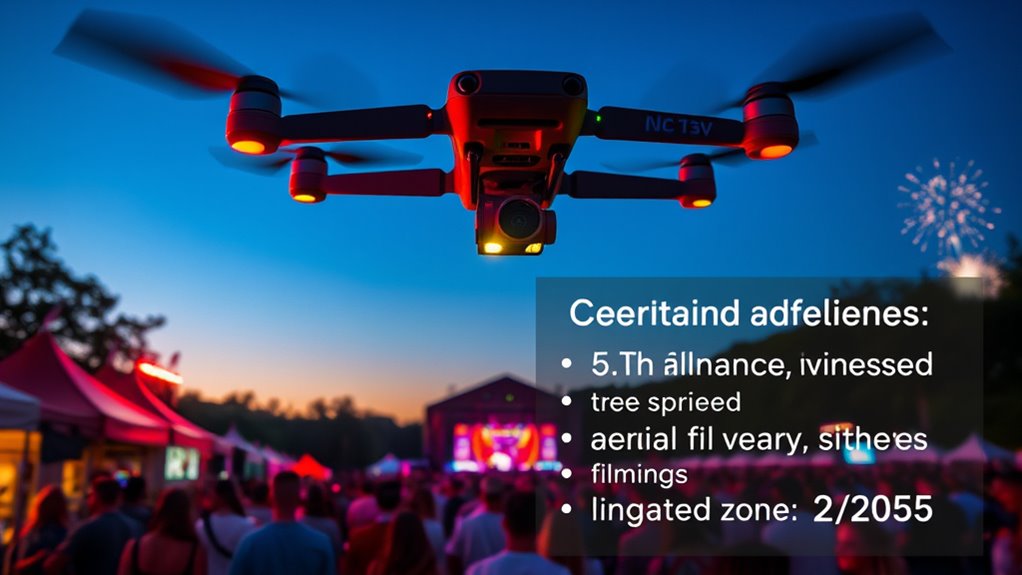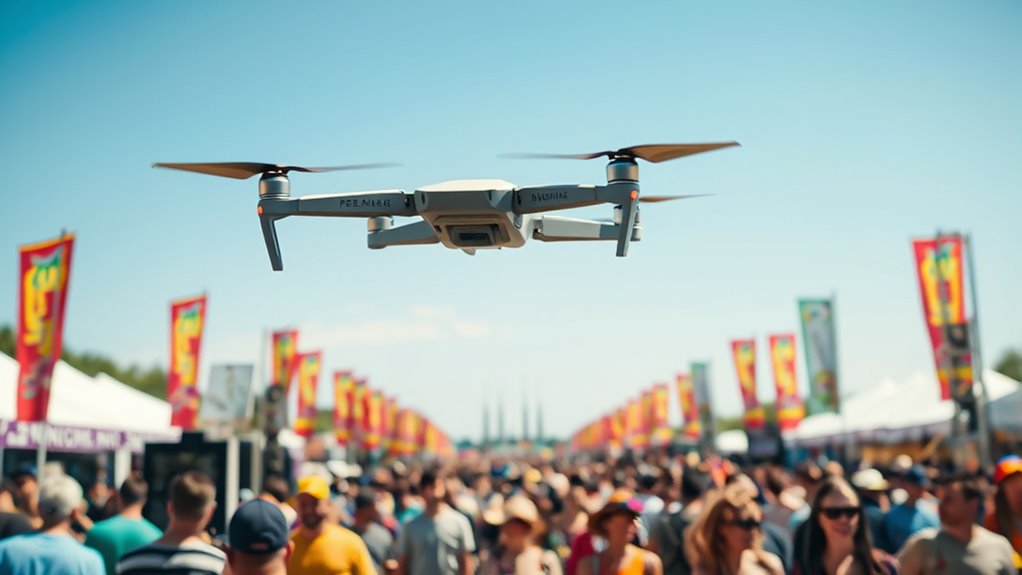In 2025, when filming at festivals with a drone, you must follow updated rules to stay safe and legal. Keep within altitude limits, usually around 120 meters, and avoid no-fly zones near airports or event areas. Always obtain necessary permissions from festival organizers and respect privacy—don’t film individuals without consent. Use obstacle avoidance technology and stay in sight of your drone. If you’re interested, continue exploring how to guarantee your drone flights are both safe and compliant.
Key Takeaways
- Check for updated local laws and temporary restrictions specific to festival dates in 2025.
- Obtain necessary permissions from festival organizers and coordinate with security teams.
- Adhere to altitude limits (around 120 meters/400 feet) and no-fly zones around sensitive areas.
- Maintain visual line of sight and avoid flying over crowds or individuals without consent.
- Respect privacy rights and ensure compliance with ethical standards during aerial filming.

Flying drones at festivals can offer stunning aerial footage, but it’s important to understand the rules that govern their use. As a drone operator, your priority should be maintaining aerial safety and ensuring legal compliance. These two elements are essential not only to avoid penalties but also to protect festival attendees, performers, and your equipment. The rules around drone use at festivals are designed to prevent accidents and interference with other activities, so paying close attention to them is crucial.
Prioritize safety and legal compliance to protect everyone and ensure smooth drone operations at festivals.
First, familiarize yourself with the specific laws and regulations that apply in your location. Many countries and regions have strict guidelines governing drone flights, especially in crowded or public spaces like festivals. Make sure you know the maximum altitude you’re allowed to fly at, which is often around 120 meters (400 feet), and adhere to no-fly zones. These no-fly zones are typically around airports, military bases, and designated event areas. Ignoring these restrictions can lead to legal penalties and risks to aerial safety. Always check for temporary flight restrictions that might be in place during the festival dates, as authorities often impose additional rules for safety reasons.
Beyond legal compliance, prioritizing aerial safety is essential. This means conducting a pre-flight risk assessment to identify potential hazards, such as crowds, power lines, or other obstacles. Maintain a visual line of sight with your drone at all times, and avoid flying over people or moving crowds unless you have explicit permission and proper safety measures in place. Keep your drone within your control, especially in dynamic environments like festivals where sudden movements or unexpected obstacles are common. Using obstacle avoidance technology can help prevent collisions, but don’t rely solely on it—always stay vigilant. Additionally, understanding the role of contrast ratio can help pilots better judge lighting conditions and avoid overexposure or poor visibility during filming.
It’s also wise to check the festival’s regulations regarding drone use. Some organizers prohibit drone flights altogether, while others may have designated areas or specific time windows for aerial filming. Always seek permission from festival authorities if required, and coordinate with security or event staff to ensure your drone operation doesn’t interfere with other activities. Respect privacy concerns by avoiding filming individuals without consent, which is both a legal and ethical consideration.
Frequently Asked Questions
Are Drone Pilots Required to Have Special Licensing for Festivals?
Yes, you need festival drone certification and meet pilot licensing requirements to operate legally at festivals. Authorities now require drone pilots to obtain specific certification to guarantee safety and compliance with airspace regulations. You must pass relevant training and certification exams to demonstrate your knowledge of drone safety protocols. Failing to satisfy these festival drone certification and pilot licensing requirements can lead to fines, penalties, or even arrest, so always stay updated and compliant.
What Are the Insurance Requirements for Drone Filming at Festivals?
You need to have adequate insurance coverage for drone filming at festivals, ensuring it meets liability requirements. This means your policy should cover potential damages or injuries caused by your drone, protecting both you and the event organizers. Make sure your insurance aligns with festival regulations, as they often specify minimum liability limits. Having proper insurance not only safeguards you financially but also helps you comply with festival rules and avoid disruptions.
Can Drones Be Used to Livestream Festival Footage Legally?
Is livestreaming festival footage with a drone walking on thin ice? Yes, it can be legal if you follow festival drone legality and livestream regulations. You must obtain proper permissions, guarantee your drone meets safety standards, and respect privacy laws. Always check local laws and festival policies beforehand. Staying compliant not only avoids fines but keeps your footage flowing smoothly—like a well-orchestrated symphony—without risking legal turbulence.
Are There Specific Drone Height Restrictions During Festival Filming?
Yes, there are specific height limitations and altitude restrictions you need to adhere to during festival filming. Usually, you shouldn’t fly your drone above 400 feet (120 meters) to stay within legal limits. These altitude restrictions are in place to ensure safety and avoid interference with manned aircraft. Always check local regulations and festival-specific rules before flying, and stay below the maximum height allowed to avoid penalties or safety issues.
How Are Privacy Concerns Addressed in Festival Drone Regulations?
You’re required to prioritize privacy protection and data security when operating drones at festivals. This means avoiding capturing identifiable images of individuals without consent and securely handling any footage collected. Regulations often mandate maintaining safe distances from attendees and restricted zones to prevent privacy breaches. By following these rules, you help guarantee festival participants’ privacy is respected, and data security is maintained, fostering a safe and enjoyable environment for everyone involved.
Conclusion
As drone filming rules at festivals evolve in 2025, you’ll find yourself balancing creativity with responsibility. Imagine capturing breathtaking moments from above, yet respecting privacy and safety. The sky is now more accessible, but with clearer boundaries. Embrace the freedom to film, knowing you’ve got guidelines to keep everyone safe. It’s like flying high in a clear blue sky—thrilling yet grounded in careful rules. Together, we can create unforgettable memories without compromising security.










